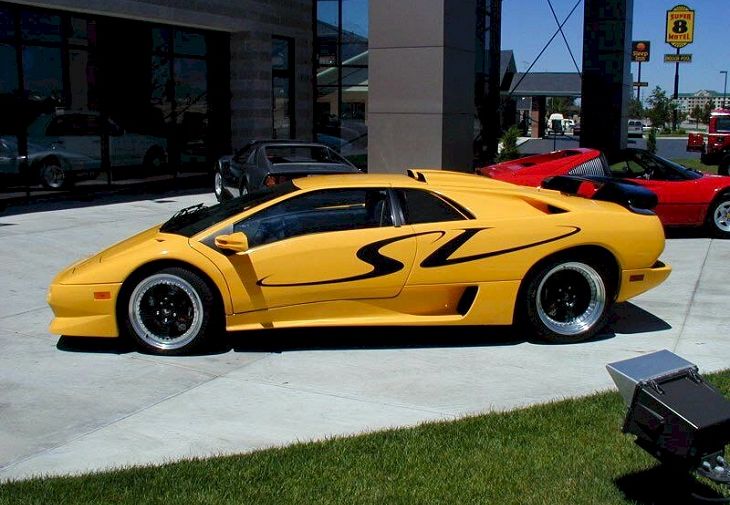Description
The Lamborghini Diablo SV, introduced in 1995, was the purest and most aggressive expression of the Diablo’s original spirit—a return to the raw, rear-wheel-drive formula that had defined Lamborghini’s greatest supercars. The initials “SV,” standing for Super Veloce (“super fast” in Italian), had last appeared on the legendary Miura SV of the early 1970s, and their revival on the Diablo signaled a renewed focus on performance, driver engagement, and mechanical purity. The Diablo SV was not a luxury grand tourer or a refined cruiser—it was a focused, visceral machine built for enthusiasts who wanted the most direct connection possible between driver, engine, and road.
The SV was introduced as part of the second generation of Diablos, debuting at the 1995 Geneva Motor Show alongside the Diablo VT Roadster. While the VT offered advanced all-wheel-drive stability, the SV took the opposite path—shedding front-drive components, reducing weight, and sharpening response. Its power came from the same 5.7-litre, 48-valve V12 engine as the Diablo VT, but with refinements to intake and fuel systems that boosted output to 510 horsepower at 7,100 rpm and 580 Nm of torque at 5,900 rpm. Power was sent exclusively to the rear wheels through a five-speed manual gearbox, giving the car a more traditional and challenging driving character. The Diablo SV could sprint from 0 to 100 km/h (62 mph) in just over 4 seconds and reach a top speed of 328 km/h (203 mph), making it one of the fastest production cars of its decade.
The chassis of the SV was a tubular steel spaceframe clothed in lightweight aluminium and composite body panels. Lamborghini engineers refined the suspension with fully adjustable Koni dampers, stiffer springs, and revised geometry, allowing the driver to tailor handling characteristics to specific driving conditions. The braking system was upgraded with larger ventilated discs and optional Brembo calipers, providing improved stopping power to match the increased performance. By removing the front differential and viscous coupling of the VT system, Lamborghini shaved around 50 kilograms from the car’s overall weight, enhancing its responsiveness and agility.
Visually, the Diablo SV was one of the most dramatic iterations of the model. The front fascia featured a new chin spoiler and integrated driving lights, while the rear gained a distinctive adjustable wing and black-finished taillight housings. The air intakes on the rear haunches were enlarged for better engine cooling, and a pair of NACA ducts were added to the engine cover to feed the intake system. The “SV” graphics—painted boldly along the sides in sweeping script—became an instant icon, emphasizing the car’s identity as a performance-focused variant. The massive 18-inch five-spoke alloy wheels, wrapped in Pirelli P Zero tyres, filled the widened arches and gave the car an imposing stance.
Inside, the SV blended the Diablo’s characteristic luxury with a more purposeful atmosphere. Deep leather seats with contrasting stitching, carbon-fiber trim, and simplified instrumentation created a cockpit that was both stylish and functional. The car was offered with adjustable pedals, air conditioning, and optional Alcantara finishes, but the focus remained on the driving experience. The seating position was low and commanding, the gear lever rising from a polished metal gate, and the visibility limited but thrilling—all classic Lamborghini trademarks.
Driving the Diablo SV was an experience of unfiltered intensity. The absence of all-wheel drive meant the car demanded respect and precision from its driver. The V12 engine responded instantly, its power delivery linear yet ferocious, and the sound—an evolving crescendo of intake growl and exhaust thunder—was unforgettable. Steering was heavy at low speeds but remarkably communicative once moving, and the car’s chassis balance rewarded skilled inputs with incredible grip and control. Unlike the VT, which could tame imperfect roads with ease, the SV felt raw and alive, constantly reminding the driver that it was a thoroughbred built for performance above all else.
The Diablo SV also featured electronically adjustable suspension, controlled via switches inside the cabin. Drivers could choose between comfort-oriented settings for road use and firmer configurations for track driving. The braking and handling balance were superb for the time, making the SV one of the most capable and engaging Diablos ever built. In capable hands, it was devastatingly fast yet beautifully balanced, its rear-wheel-drive layout providing the kind of feedback and excitement that defined classic Lamborghinis.
Production of the Diablo SV continued until 1999, with several minor updates introduced during its lifespan. The later 1998 models featured revised headlights, a new dashboard design, and the availability of an optional 530-horsepower upgrade. Roughly 300 examples of the SV were produced, making it one of the rarer variants in the Diablo lineage. Each car was hand-assembled at Lamborghini’s Sant’Agata Bolognese factory and available in a range of vibrant colors, from deep blues and fiery reds to the trademark bright yellows and purples that became synonymous with the 1990s Lamborghini aesthetic.
The Diablo SV stands today as one of the most beloved and collectible versions of the Diablo range. It was the last Lamborghini to embody the brand’s traditional approach to supercar design before the increasing introduction of electronic assistance and computer control. It captured the raw, mechanical purity that enthusiasts still revere—a car that demanded attention, skill, and passion in equal measure.
The Diablo SV remains a defining symbol of Lamborghini’s philosophy: bold, beautiful, and uncompromising. It bridged the gap between the feral intensity of the early Countach and the more modern sophistication of the Murciélago, combining old-school power with 1990s engineering precision. Even today, the Diablo SV stands as a visceral reminder of a time when supercars were ruled by sound, sensation, and sheer willpower—a machine built for those brave enough to tame it.
